Notes: Penygroes was situated on the Menai Bridge – Afon Wen line which opened in stages between 1852 and 1871. It was on the western edge of the village from which it took its name. The section of line through Penygroes was originally part of the Nantlle Railway, a horse-drawn tramway opened in 1827 linking slate quarries at Nantlle with Caernarfon’s quayside. Passenger services were operated between 11 August 1856 and 12 June 1865, and one of the stations on the line was at Penygroes. Facilities - if there were any - would have been basic. On 29 July 1862 the Carnarvonshire Railway (CR) was authorised to build a line between Caernarfon and Afon Wen. The CR took over the Nantlle Railway between Penygroes and Caernarfon, but not the section up to Nantlle which remained a horse-drawn tramway. In October 1866 the largely completed CR was inspected, but its opening was not approved until 2 September 1867 by which time all work was finished.
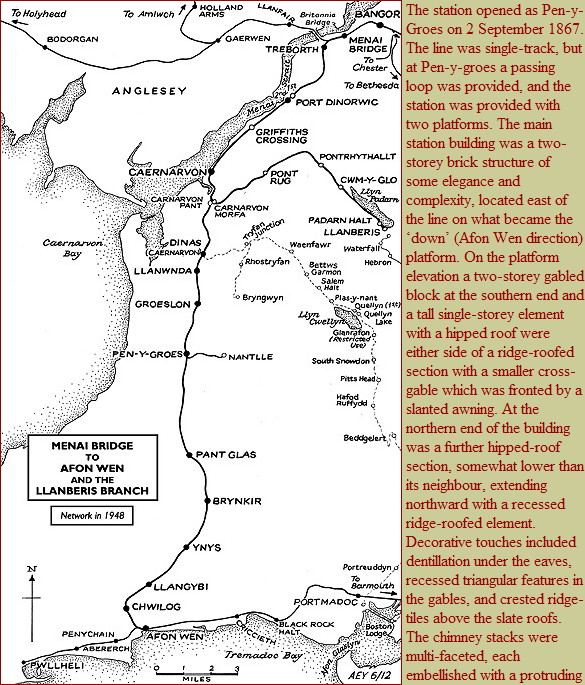 |
ledge and square chimney pots with spiked corners. On the frontage the two-storey southern block repeated its platform face, but the northern hipped-roof single-storey section carried a large gable-end, with the recessed triangular decoration. The central section, which carried one cross-gable on the platform elevation, presented two gables to the frontage. Within the building were waiting rooms for both sexes, a booking hall, porters’ office, lamp room, a weigh office, toilets for both sexes and accommodation for the stationmaster. On the ‘up’ platform a stone waiting shelter with slate roof was provided. A bridge carried Clynnog Road over the line immediately north of the station building. Originally the platforms ended at the bridge but later they were extended under it northwards.
Penygroes had goods sidings west side of the line, south of the station. In 1867 there were also transhipment sidings east of the line, again south of the station; the Nantlle Railway terminated at the transhipment sidings.
| At first passenger services ran between Carnarfon Pant and Afon Wen with some trains continuing beyond Afon Wen onto the Cambrian Railway which was not completed and did not open throughout until 10 October 1867. There were five up and five down trains on Monday-to-Saturday and one in each direction on Sundays. From January 1871, with the |
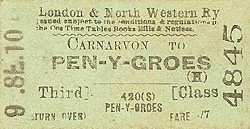 |
completion of the Carnarvon Town line, trains were able to run between Bangor and Afon Wen. From 4 July 1870 the CR had become part of the London & North Western Railway (LNWR).
The quarry owners at Nantlle were frustrated with the situation that existed after the CR had taken over the Nantlle Railway. Previously their products had been worked over the Nantlle Railway direct to the quayside at Caernarfon, but as the CR line was built to standard gauge and the Nantlle was 3ft 6in this was not possible after 1867. Slate had to be transhipped at Penygroes and again at Caernarfon, which added to costs and resulted in more breakages of slates. To improve the situation in 1870 the LNWR took over the section of the Nantlle Railway, extending to just over a mile, from Penygroes to Nantlle. It was converted to standard gauge and connected directly with the former CR line via a junction immediately south of Penygroes station. The converted line became the Nantlle branch and began operation for goods on 1 August 1872; a passenger service was introduced on 1 October 1872. As most of the Nantlle passenger services originated from, and terminated at, Penygroes, a bay platform was created to the rear of the down platform at the southern end. An LNWR 33-lever signal box just beyond the end of the down platform controlled the junction, the passing loop and access to the goods yard. A footbridge south of the station building, linking the two platforms, had also been provided by this time.
By December 1895 Penygroes had six up and eleven down trains Monday to Friday as shown in the table below. There were also five services that terminated at Penygroes from Nantlle. Extra trains ran on Saturdays and there was a train in each direction on Sundays.
| Up Trains (Menai Bridge direction) December 1895 |
Destination |
Down Trains (Afon Wen direction) December 1895 |
Destination |
| 8.02am |
Bangor |
6.00am |
Afon Wen |
| 9.08am (Saturdays Only) |
Carnarvon |
10.13am |
Afon Wen |
| 11.40am (Saturdays Only) |
Carnarvon |
10.15am |
Nantlle |
| 11.57am |
Bangor |
1.03pm |
Nantlle (Afon Wen on Mondays Only) |
| 2.28pm |
Bangor |
1.05pm |
Nantlle |
| 5.09pm |
Bangor |
3.18pm |
Afon Wen |
| 7.37pm |
Bangor |
3.20pm |
Nantlle |
| 9.35pm |
Carnarvon |
5.08pm |
Afon Wen |
| |
|
5.10pm |
Nantlle |
| |
|
7.08pm (Saturdays Only) |
Nantlle |
| |
|
8.24pm |
Afon Wen |
| |
|
8.26pm |
Nantlle |
In 1904 the LNWR changed the spelling of Pen-y-Groes to Penygroes. Interestingly they did not alter the signal box nameboard. By July 1922 there were eight up trains and eighteen down trains, eleven of which were Nantlle shuttles, Monday to Friday as seen in the table below. There were twelve services from Nantlle all but the last of which terminated at Penygroes. There was an extra up train on Saturdays and no Sunday service.
| Up Trains (Menai Bridge direction) July 1922 |
Destination |
Down Trains (Afon Wen direction) July 1922 |
Destination |
| 7.37am (Saturdays Only) |
Bangor |
5.38am |
Afonwen |
| 8.20am |
Carnarvon |
7.40am |
Nantlle |
| 10.10am |
Bangor |
9.13am |
Nantlle |
| 11.40am |
Bangor |
9.38am |
Afonwen |
| 2.29pm |
Bangor (With through coach for London Euston) |
9.45am |
Nantlle |
| 4.43pm |
Bangor |
10.15am |
Nantlle |
| 6.18pm |
Bangor |
11.45am |
Nantlle |
| 7.40pm |
Bangor |
12.15pm |
Afonwen |
| 9.47pm |
Carnarvon |
1.14pm |
Afonwen |
| |
|
1.20pm |
Nantlle |
| |
|
2.35pm |
Nantlle |
| |
|
2.48pm (Saturdays Only) |
Pwllheli |
| |
|
2.59pm (Saturdays Excepted) |
Pwllheli |
| |
|
3.05pm |
Nantlle |
| |
|
4.50pm |
Nantlle |
| |
|
5.47pm |
Pwllheli |
| |
|
5.55pm |
Nantlle |
| |
|
6.25pm |
Nantlle |
| |
|
8.06pm |
Afonwen |
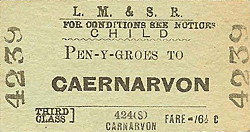 |
During the Great War the LNWR experimented with a petrol-electric railcar which they used on services between Penygroes and Nantlle. It was a single coach and could pull no more than its own weight. It was therefore of no use in shunting wagons, an operation which locomotives hauling the passenger service had previously performed. During the winter period its |
roof-mounted radiators froze. The experiment was not a success, and so few were the passengers using the line that the Nantlle service was withdrawn for a period between 1 January 1917 and 5 May 1919.
On 1 January 1923 Penygroes became part of the London Midland & Scottish Railway (LMS). By 1928 they were running twelve up and nine down trains Monday to Friday with only a few services on the Nantlle branch. A few years later, in summer 1932 there were ten up and nine down main line trains and twelve services each way on the Nantlle branch Moday to Friday. Passenger services to Nantlle ceased on 8 August 1932, but excursion trains continued until 1939.
| With the outbreak of the Second World War an emergency timetable was introduced from 11 September 1939, and Penygroes had only three trains in each direction on Monday-to-Saturday. The service was improved from 1 January 1940 when six trains ran in each direction on Monday-to-Saturday. On 1 January 1948 Penygroes became part of the British |
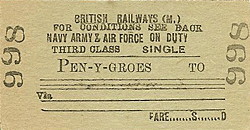 |
Railways London Midland Region. The summer 1948 timetable showed eight up and eight down services Monday to Friday with retimed trains and an extra up train on Saturdays as shown in the table below.
| Up Trains (Menai Bridge direction) Summer 1948 |
Destination |
Down Trains (Afon Wen direction) Summer 1948 |
Destination |
| 7.10am |
Bangor |
5.43am |
Pwllheli |
| 8.42am (Saturdays Excepted) |
Bangor |
6.41am |
Afon Wen |
| 8.50am (Saturdays Only ) |
Llandudno Junction |
9.50am |
Afon Wen |
| 11.17am (Saturdays Only ) |
Liverpool Lime Street |
1.07pm |
Afon Wen |
| 11.27am (Saturdays Excepted) |
Bangor |
3.41pm (Saturdays Excepted) |
Afon Wen |
| 11.51am (Saturdays Only ) |
Manchester Exchange |
4.02pm (Saturdays Only) |
Afon Wen |
| 4.29pm (Saturdays Excepted) |
Bangor |
4.57pm (Saturdays Excepted) |
Afon Wen |
| 4.38pm (Saturdays Only ) |
Bangor |
5.31pm (Saturdays Only ) |
Afon Wen |
| 5.53pm (Saturdays Excepted) |
Bangor |
6.20pm (Saturdays Excepted) |
Afon Wen |
| 6.00pm (Saturdays Only ) |
Bangor |
6.27pm (Saturdays Only ) |
Afon Wen |
| 7.44pm |
Bangor |
8.52pm |
Afon Wen |
| 9.22pm |
Bangor |
|
|
| 10.27pm |
Bangor |
|
|
In 1939 Billy Butlin built a holiday camp at Penychain on the former Cambrian line to the west of Afon Wen. Due to the war it did not open for holidaymakers until the summer season of 1947 although it was used during the war by the Royal Navy. The opening of the holiday camp brought a lot of extra traffic in the form of holiday specials to the Menai Bridge – Afon Wen line during the summer months which were much longer than the routine service trains. At many of the stations, including Penygroes, platforms were lengthened. Even the scheduled services had improved by the mid 1950s. The summer timetable for the Summer of 1955 showed ten up and eleven down trains Monday to Friday as seen in the table below. On Saturdays there were sixteen up and seventeen down services but no service on Sundays.
| Up Trains (Menai Bridge direction) Summer 1955 |
Destination |
Down Trains (Afon Wen direction) Summer 1955 |
Destination |
| 7.05am |
Bangor (To Manchester Exchange on Saturdays) |
5.13am |
Afonwen |
| 8.36am (Saturdays Excepted) |
Bangor |
6.21am |
Pwllheli |
| 8.49am (Saturdays Only) |
Liverpool Lime Street |
7.20am |
Penychain |
| 9.35am (Saturdays Only) |
Stoke-on-Trent |
8.43am (Saturdays Excepted ) |
Afonwen |
| 10.29am (Saturdays Only) |
Manchester Exchange |
8.52am (Saturdays Only) |
Penychain |
| 10.54am (Saturdays Only) |
London Euston |
9.50am |
Afonwen |
| 11.17am (Saturdays Only) |
Liverpool Lime Street |
10.08am (Saturdays Only) |
Penychain |
| 11.24am (Saturdays Excepted ) |
Bangor |
11.49am (Saturdays Only) |
Penychain |
| 11.48am (Saturdays Only) |
Manchester Exchange |
12.01pm (Saturdays Only) |
Penychain |
| 11.54am (Saturdays Excepted ) |
London Euston |
12.18pm (Saturdays Excepted ) |
Pwllheli |
| 12.22pm (Saturdays Only) |
Warrington Bank Quay |
12.23pm (Saturdays Only) |
Pwllheli |
| 12.59pm (Saturdays Only) |
Manchester Exchange |
1.01pm (Saturdays Only) |
Penychain |
| 2.14pm (Saturdays Only) |
Holyhead |
1.06pm (Saturdays Excepted ) |
Afonwen |
| 2.40pm |
Bangor |
1.19pm (Saturdays Only) |
Penychain |
| 3.20pm (Saturdays Only) |
Holyhead |
1.31pm (Saturdays Only) |
Pwllheli |
| 4.27pm (Saturdays Excepted ) |
Bangor |
2.56pm (Saturdays Only) |
Penychain |
| 4.30pm (Saturdays Only) |
Bangor |
3.40pm (Saturdays Excepted ) |
Pwllheli |
| 4.48pm (Saturdays Only) |
Llandudno Junction |
4.05pm (Saturdays Only) |
Afonwen |
| 5.52pm (Saturdays Excepted ) |
Bangor |
5.24pm |
Portmadoc |
| 7.41pm |
Bangor |
6.24pm |
Pwllheli |
| 8.39pm (Saturdays Excepted ) |
Bangor |
7.53pm (Saturdays Excepted ) |
Afonwen |
| 8.45pm (Saturdays Only) |
Bangor |
8.05pm (Saturdays Only) |
Afonwen |
| 9.04pm (Saturdays Excepted ) |
Bangor |
|
|
| 9.14pm (Saturdays Only) |
Bangor |
|
|
DMUs were introduced onto many services from 1958. The line remained busy in the summer months into the 1960s but during the winter period it was very quiet. Goods services on the Nantlle branch ceased on 2 December 1963. By the end there was only a single train, and it ran only on alternate days. The Reshaping of British Railways (‘Beeching’) report of 1963 recommended that the line between Caernarfon and Afon Wen be closed completely. This was despite the very heavy holiday traffic in the summer. Interestingly in 1964 steam-hauled trains were used on most services with DMUs being sent elsewhere. The line closed completely on 7 December 1964 with the last services running on Saturday 5 December.
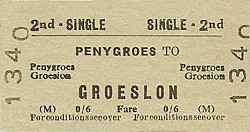 |
The line through Penygroes was not lifted immediately, and track remained in situ in 1966, although tracks in the goods yard had been taken up earlier. The station building remained in use as a residence for a period but had become derelict by the 1970s and was demolished by 1975, but the platforms survived. In 1975 a haulage road was constructed through the site |
of Penygroes by MacAlpines; it ran from Llanwnda and Pant Glas and was used by lorries carrying stone.
In 2000 the Penygroes bypass was constructed along the trackbed through the site of Penygroes station leaving no trace of it.
Timetable from Nick Catford, tickets from Michael Stewart route map drawn by Alan Young
Sources:
To see the other
stations on the Menai Bridge - Afonwen line click on the station
name: Menai Bridge, Treborth, Port Dinorwic (1st), Port Dinorwic (2nd), Griffiths Crossing, Caernarvon, Carnarvon Pant, Dinas, Llanwnda, Groeslon, Pant Glas, Brynkir, Ynys, Llangybi, Chwilog & Afon Wen
See also: Nantlle
|

old10.jpg)
.jpg)
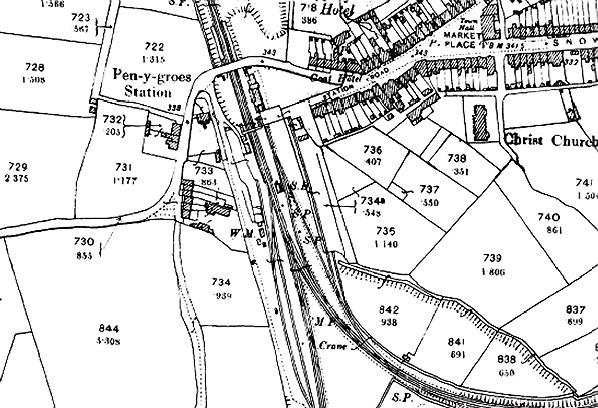
old3.jpg)
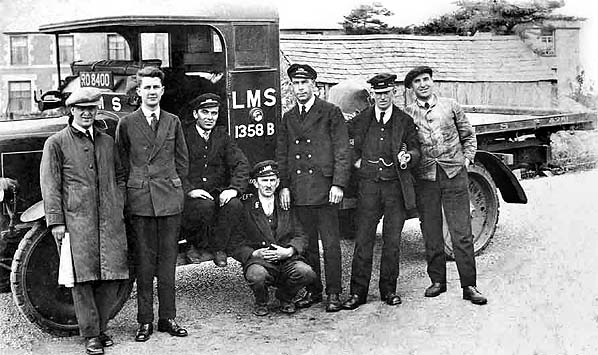
old4.jpg)
old12.jpg)
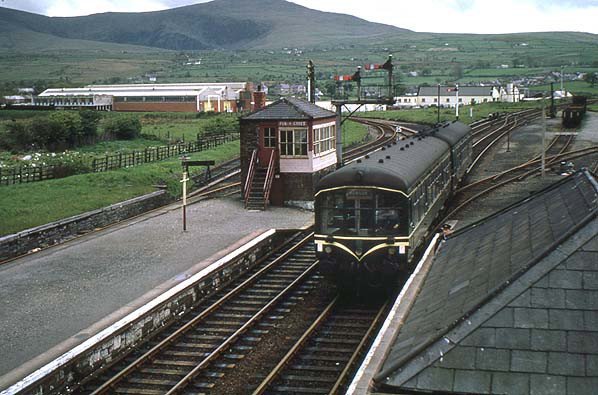
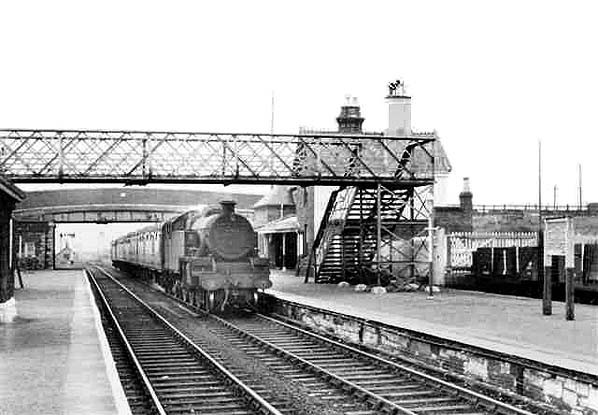
old8.jpg)
1.jpg) By 1975 the station buildings at Penygroes and the signal box had been demolished. Amazingly the footbridge was in situ, and the platforms could still be seen. The track had been lifted and replaced with a haulage road which used by lorries to carry stone between a quarry near Pant Glas and Llanwnda.
By 1975 the station buildings at Penygroes and the signal box had been demolished. Amazingly the footbridge was in situ, and the platforms could still be seen. The track had been lifted and replaced with a haulage road which used by lorries to carry stone between a quarry near Pant Glas and Llanwnda.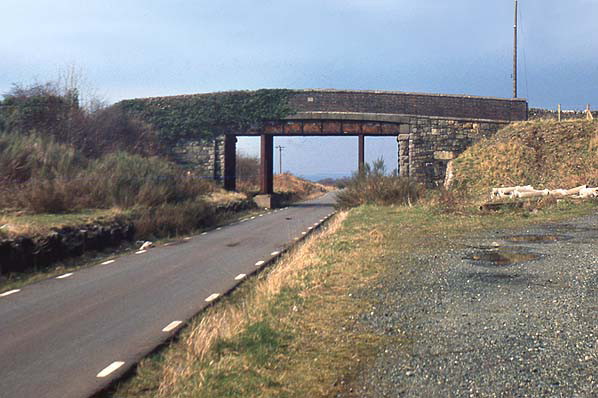





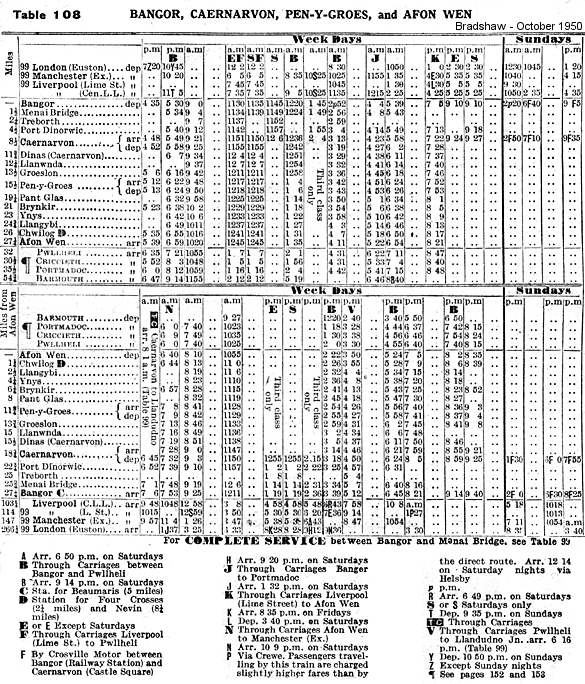
old2.jpg)


old5.jpg)
old6.jpg)

old9.jpg)
14.jpg)

 Home Page
Home Page